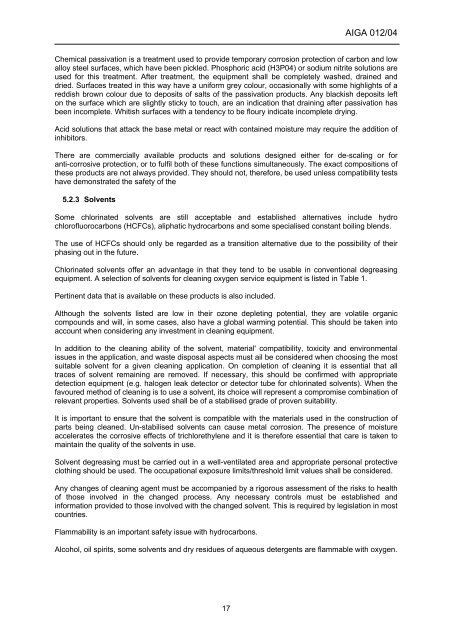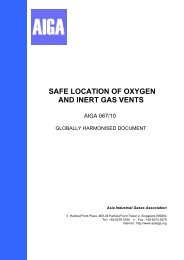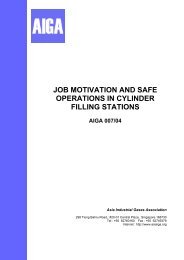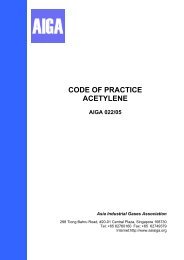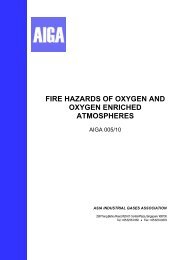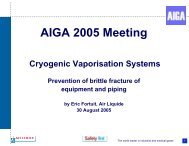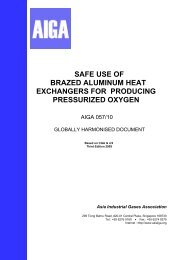CLEANING OF EQUIPMENT FOR OXYGEN SERVICE - AIGA
CLEANING OF EQUIPMENT FOR OXYGEN SERVICE - AIGA
CLEANING OF EQUIPMENT FOR OXYGEN SERVICE - AIGA
You also want an ePaper? Increase the reach of your titles
YUMPU automatically turns print PDFs into web optimized ePapers that Google loves.
17<br />
<strong>AIGA</strong> 012/04<br />
Chemical passivation is a treatment used to provide temporary corrosion protection of carbon and low<br />
alloy steel surfaces, which have been pickled. Phosphoric acid (H3P04) or sodium nitrite solutions are<br />
used for this treatment. After treatment, the equipment shall be completely washed, drained and<br />
dried. Surfaces treated in this way have a uniform grey colour, occasionally with some highlights of a<br />
reddish brown colour due to deposits of salts of the passivation products. Any blackish deposits left<br />
on the surface which are slightly sticky to touch, are an indication that draining after passivation has<br />
been incomplete. Whitish surfaces with a tendency to be floury indicate incomplete drying.<br />
Acid solutions that attack the base metal or react with contained moisture may require the addition of<br />
inhibitors.<br />
There are commercially available products and solutions designed either for de-scaling or for<br />
anti-corrosive protection, or to fulfil both of these functions simultaneously. The exact compositions of<br />
these products are not always provided. They should not, therefore, be used unless compatibility tests<br />
have demonstrated the safety of the<br />
5.2.3 Solvents<br />
Some chlorinated solvents are still acceptable and established alternatives include hydro<br />
chlorofluorocarbons (HCFCs), aliphatic hydrocarbons and some specialised constant boiling blends.<br />
The use of HCFCs should only be regarded as a transition alternative due to the possibility of their<br />
phasing out in the future.<br />
Chlorinated solvents offer an advantage in that they tend to be usable in conventional degreasing<br />
equipment. A selection of solvents for cleaning oxygen service equipment is listed in Table 1.<br />
Pertinent data that is available on these products is also included.<br />
Although the solvents listed are low in their ozone depleting potential, they are volatile organic<br />
compounds and will, in some cases, also have a global warming potential. This should be taken into<br />
account when considering any investment in cleaning equipment.<br />
In addition to the cleaning ability of the solvent, material' compatibility, toxicity and environmental<br />
issues in the application, and waste disposal aspects must ail be considered when choosing the most<br />
suitable solvent for a given cleaning application. On completion of cleaning it is essential that all<br />
traces of solvent remaining are removed. If necessary, this should be confirmed with appropriate<br />
detection equipment (e.g. halogen leak detector or detector tube for chlorinated solvents). When the<br />
favoured method of cleaning is to use a solvent, its choice will represent a compromise combination of<br />
relevant properties. Solvents used shall be of a stabilised grade of proven suitability.<br />
It is important to ensure that the solvent is compatible with the materials used in the construction of<br />
parts being cleaned. Un-stabilised solvents can cause metal corrosion. The presence of moisture<br />
accelerates the corrosive effects of trichlorethylene and it is therefore essential that care is taken to<br />
maintain the quality of the solvents in use.<br />
Solvent degreasing must be carried out in a well-ventilated area and appropriate personal protective<br />
clothing should be used. The occupational exposure limits/threshold limit values shall be considered.<br />
Any changes of cleaning agent must be accompanied by a rigorous assessment of the risks to health<br />
of those involved in the changed process. Any necessary controls must be established and<br />
information provided to those involved with the changed solvent. This is required by legislation in most<br />
countries.<br />
Flammability is an important safety issue with hydrocarbons.<br />
Alcohol, oil spirits, some solvents and dry residues of aqueous detergents are flammable with oxygen.


